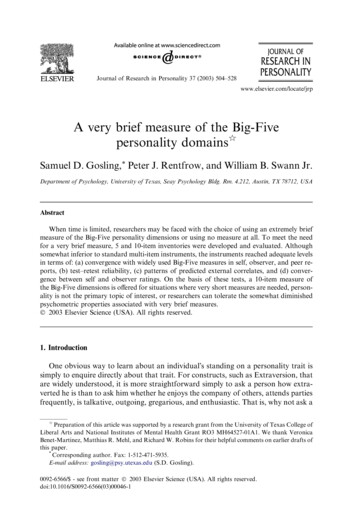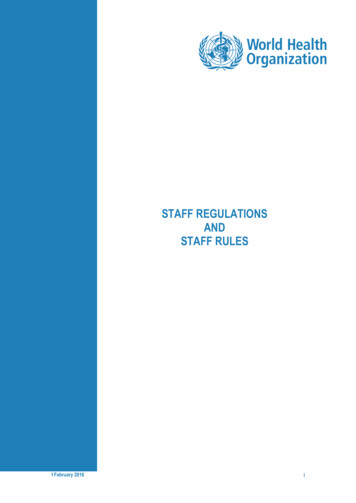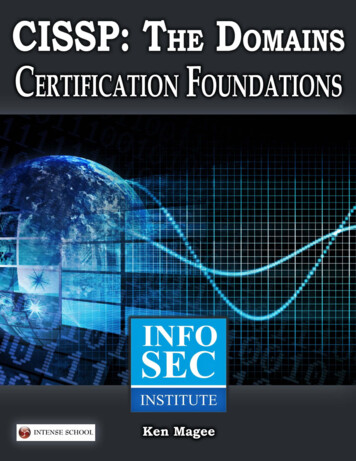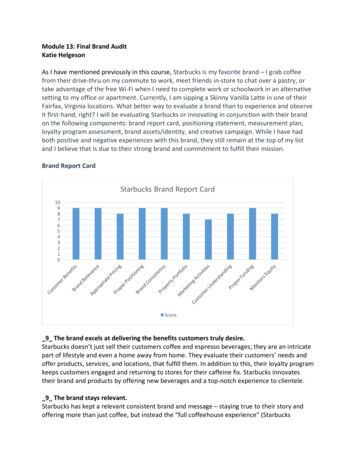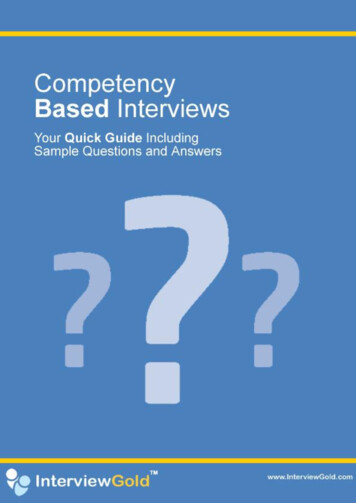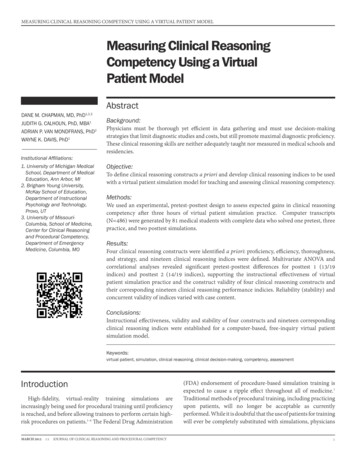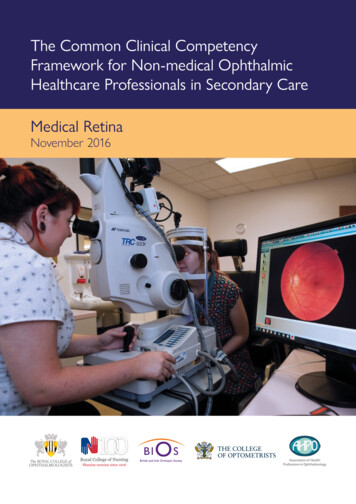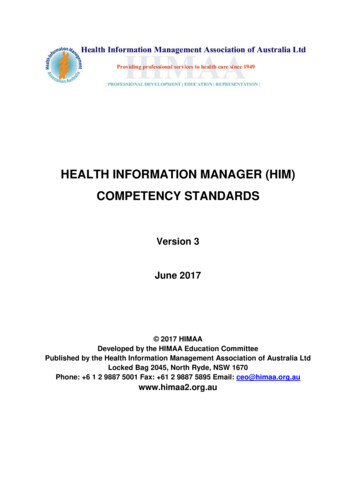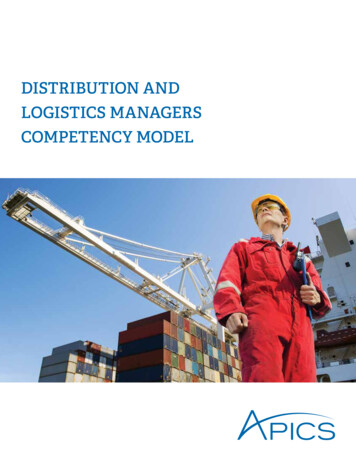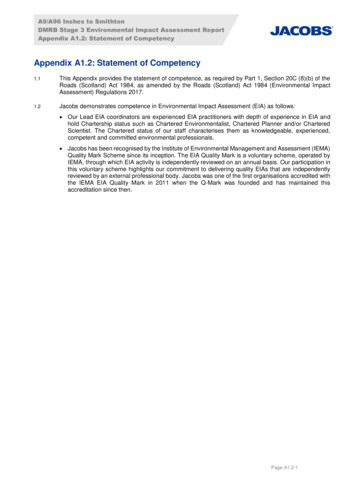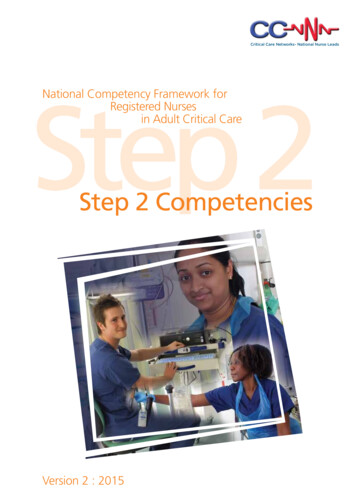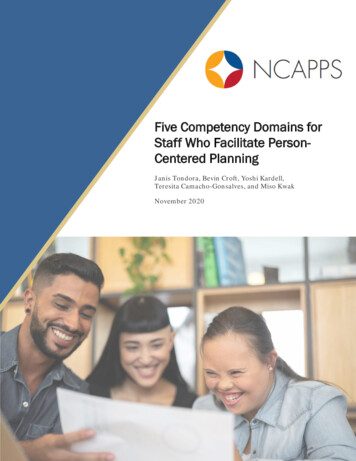
Transcription
Five Competency Domains forStaff Who Facilitate PersonCentered PlanningJanis Tondora, Bevin Croft, Yoshi Kardell,Teresita Camacho-Gonsalves, and Miso KwakNovember 2020
IIntroductionPerson-centered planning (PCP) is a way to learn about the choices and interests thatmake up a person’s idea of a good life—and to identify the supports (paid and unpaid)needed to achieve that life. It is not something you do to a person, nor is it somethingyou do for a person; instead, it is directed by the person, with support from afacilitator as needed and desired. The facilitator might be a case manager, supportcoordinator, clinician, peer specialist, or another independent staff person who isspecifically tasked with helping to co-create a person-centered plan.The methods used to undertake person-centered planning may vary based on theunique structures of systems and the unique needs and preferences of the people theysupport. But in all circumstances, the relationship between the person and thefacilitator is a mutually respectful partnership where the plan is co-created with thegoal of helping the person realize their unique vision of a good life.To date, there are no universally agreed upon standards, or competencies, for humanservice agency staff tasked with facilitating person-centered planning. Such standardsare needed to ensure the planning process is consistent with the values and principlesof person-centered thinking, planning, and practice. This resource describes five skillareas, or domains, that facilitators should possess to support a fully person-centeredplanning process.This resource was created as partof technical assistance provided byFive Person-Centered Planni11gthe National Center on AdvancingCompetency DomainsPerson-Centered Practices andA Strengths Based, Cu ltura llySystems (NCAPPS). It builds fromInformed, Who le Person-Foc usedthe rich history of foundationalapproaches to person-centeredB. Cu lti vat ing Connections Insideplanning as well as the 2020the System and OutPerson-Centered Planning andC. Rights, Cho ice , and Contro lPractice Final Report from theD Partners hip, Teamwork ,National Quality Forum (NQF),Commun icat ion, and Facilitationwhich outlines a set of corecompetencies for person-centeredE Documentation, Implementation,planning facilitation, identified byand Monitoringa multi-stakeholder expert panel.See Appendix A for a full list ofresources that were used toestablish the five domains presented here.1
Staff Competency Domains for Person-Centered PlanningWho It’s ForThis resource is for human service agency leadership who oversee the organizationand delivery of services and supports. It applies to a wide range of systems supportingindividuals with various types of disabilities, people with behavioral health-relatedneeds, and older adults with long-term service and support needs. The fivecompetency domains can inform hiring, training, and supervision; qualityimprovement activities; and other systems change initiatives.The information in this document is also useful for people who receive services andtheir loved ones. The five domains described here give people an idea of the type ofpartnership they should expect when working alongside people who facilitate andsupport the person-centered planning process.A Note About Systems and PeopleStaff competency in PCP is only one aspect of a larger system that is needed tosupport person-centered thinking and planning. To be truly person-centered, humanservice systems must have policies, procedures, and infrastructure that supportengagement, equity, access, coordination, self-direction, community inclusion, and arange of other factors. Even the most competent and committed PCP facilitators willnot be able to fully actualize their competency in practice in the absence of systemscharacteristics that align in support of person-centered planning. Thesecharacteristics are discussed in the recent report from the National Quality Forum;forthcoming NCAPPS resources will provide additional support for measuring,implementing, and promoting person-centered systems.Finally, it is critical to remember that person-centered planning is, first and foremost,about the person, not the facilitator or the system. Although this particular resourcefocuses on the skills of people who help to facilitate person-centered planning, thisfocus should not be taken as diminishing the primary role of the person who shouldalways be at the center of the planning process.How We Arrived at the DomainsThis work began with 16 national sources that outline essential skills, practicestandards, federal regulations, and learning objectives for person-centered thinking,planning, and practice from a range of fields, including intellectual anddevelopmental disability services, behavioral health services for adults andchildren/youth, and aging and physical disability services. These source documentsare listed in Appendix A.The work was led by Janis Tondora of the Yale University Program for Recovery andCommunity Health. The team also included NCAPPS staff from the Human ServicesResearch Institute who collectively brought a wide range of both professional2
Staff Competency Domains for Person-Centered Planningexpertise and lived experience to the process. The team used thematic analysis, aqualitative research approach, to organize the material and develop the domains.In extracting 400 potential competencies from the 16 source documents, it becameclear to us that different service systems were using different terms to describe similarconcepts. In the behavioral health field, for example, “recovery-oriented” is analogousto “person-centered” in describing systems that provide individualized, holisticsupports focused on promoting a desired life in the community. It also became clearthat there were several areas that were valued across all sources—based on thefrequency with which they appeared and their salience to the values and principles ofperson-centered thinking, planning, and practice. These commonly identified themeswere proposed by the team lead (Janis Tondora) as an initial set of competencydomains and shared with the remaining NCAPPS team (Bevin Croft, Yoshi Kardell,Teresita Camacho-Gonsalves, and Miso Kwak) along with a master spreadsheet thatassigned or “coded” each of the 400 potential competencies according to the specificdomain they seemed most closely aligned with.Next, all members of the team reviewed the team lead’s spreadsheet, making note ofwhether they agreed with the initial domain coding and/or whether other domainsmight be more applicable. Across all team members, there was a high degree ofagreement in the coding across over 90% of the items. This high level of agreementsupports the reliability of the process and the coding structure. Any discrepancies inthe domains or the individual coding of competencies were then discussed by the fullteam in a series of working meetings until there was a consensus-based opinion on aset of five competency domains presented here.Next, the team met with three members of NCAPPS’ Person-Centered Advisory andLeadership Group (PAL Group). After reviewing the process and the domains, thePAL Group members were asked whether the information presented here resonatedwith their experiences of person-centered planning. The PAL Group membersprovided the team with valuable feedback that led to further revision of this documentand the descriptions of the domains.3
IFive Competency DomainsIn this section we describe the underlying principles and assumptions of each of theDomains and present a numbered list of associated competencies, which wereinformed by the original source documents.A. Strengths Based.CulturallyInformed.Whole Person- FocusedE.Documentation.Implementation.and MonitoringD. Partnership.Teamwork.Communication.and FacilitationFive Person CenteredPlanningCompetencyDomainsB. CultivatingConnectionsInside theSystem and OutC. Rights.Choice.andControl4
Staff Competency Domains for Person-Centered PlanningA. Strengths-Based, Culturally Informed,Whole Person–FocusedPerson-centered planning recognizes that people grow, change, andcan realize personally valued goals. PCP focuses on the universallyvalued goal of living a good life as defined by the person. All activitiesfocus on the person as a whole (not just their diagnosis or disability) and are informedby the person’s unique culture and identity.1.Demonstrates self-awareness and practices cultural humility. Person-centeredpractitioners must be cognizant of their own power and privilege, culturalassumptions, psychological development and temperament, personalitydynamics, and prejudices to avoid imposing their beliefs on the process.Similarly, practitioners are aware of the values and cultural biases of theservice system and recognize that the person’s values and culture may notalign with the system’s values and culture.2.Learns about a person’s cultural and linguistic preferences and experiences oftrauma (personal or historical) and draws on this learning when partneringwith the individual in the planning process. Recognizes cultural and linguisticfactors such as individualism and collectivism, language and communication,values and beliefs, customs and rituals, relationships to authority figures,avoidance of uncertainty, relationships to time, and other cross-culturaldifferences that need to be understood and respected in the person-centeredplanning process and its goal of community inclusion.3.Skillfully uses available person-centered tools to support goal discovery,visioning, and self-direction.4.Conveys high expectations for meaningful outcomes across a broad range ofquality of life areas valued by the person that go far beyond the managementof a disability or diagnosis.5.Creates a comprehensive, strengths-based profile with the person that helpsthem discover or rediscover themselves as a whole person with strengths andinterests beyond their disability or diagnosis.5
Staff Competency Domains for Person-Centered PlanningB. Cultivating Connections Inside theSystem and OutPlanning facilitates linkages with both paid (professional) andunpaid (natural) supports. This requires understanding of theperson’s relevant health or disability issues as well as knowledge ofthe array of systems the person may access. All activities seek to maximizeconnections to natural community activities and relationships in inclusive settingswherever possible and when consistent with the preferences of the person.1.Understands the systems and supports a person may choose to access(e.g., LTSS) and facilitates linkages as appropriate, e.g., to health care, socialservices, entitlement programs, recreation and leisure, housing andemployment supports, faith-based opportunities, employment resources,culturally specific resources, and safety net providers such as food pantriesand clothing donations.2.Understands basic issues related to different populations served, e.g., olderadults and people with physical disabilities, intellectual/developmentaldisabilities, mental health challenges, brain injury, or Alzheimer’s disease orcognitive impairment.3.Promotes the person’s connection to the valued natural community activitiesand relationships that matter most to them. Encourages a person’sexperiences and activities beyond those provided in segregated environmentsdesigned only for people with disabilities or specific diagnoses.4.Actively involves family caregivers and/or other supporters in collaborativelydeveloping and executing the person-centered plan in accordance with thepreferences of the person.5.Supports the creation or maintenance of a meaningful life in the community(as defined by each individual) as a fundamental human right and notsomething that must be earned by the demonstration of “stability” or acts ofcompliance with professional recommendations.6
Staff Competency Domains for Person-Centered PlanningC. Rights, Choice, and ControlRelationships and planning activities are based on respect and theassumption that people are presumed competent and have the right tocontrol decisions that impact their lives. Practitioners support people inempowering themselves and discovering their voice in all aspects of plan co-creationand implementation. Practitioners are aware of and able to educate people (whennecessary and desired) about the range of legal protections that promote bothfundamental safety (i.e., the right to be free from abuse and neglect) and communityinclusion (i.e., the right to be free from discrimination and the right to exercisefreedoms).1.Presumes competence. All people are presumed to have the capacity, and theright, to actively participate in the planning process.2.Understands the concepts of dignity of risk and the right to fail. With theexception of some emergency situations, does not (directly or indirectly) placelimits or restrictions on a person’s freedom or activities out of a desire toprotect them or act in their best interest.3.Provides basic education about one’s rights in services (including the right toreceive conflict-free case management when supported by Medicaid-fundedhome and community-based services) as well as one’s right to be free fromdiscrimination both within the service system and in the community at large.This requires a basic knowledge of the history and achievements of advocacygroups across disability and aging at the national level—including the passageof rights legislation such as the Americans with Disabilities Act (ADA),Olmstead, the Patient Self-Determination Act, etc.4.Supports people to advocate for themselves (and/or advocates for them whenappropriate and desired) when their preferences or values are not beinghonored in the person-centered planning process and during times of tensionor disagreement with providers or supporters.5.Practices supported decision-making, a series of relationships, interventions,arrangements, and agreements designed to assist a person to make andcommunicate to others decisions about their life, often around alternatives toguardianship and other legally sanctioned restrictions to freedom for peoplewith disabilities.6.Understands how to recognize abuse, neglect, and exploitation and the legaland administrative requirements related to the handling and reporting of suchviolations.7
Staff Competency Domains for Person-Centered PlanningD. Partnership, Teamwork, Facilitation,and CoordinationPlanning interactions and meetings are facilitated in a respectful,professional manner and in accordance with person-centeredprinciples and the preferences of each individual. Ensures theprimary focus remains on the priorities and perspective of the person. Supports theperson in expanding their team or circle as desired. Encourages all members to makemeaningful contributions and facilitates the process in a way that is transparent andaccessible to all parties involved.1.Attends to language and respects the preferences of the person. Understandsthe nuances behind person-first vs. identity-first language.2.Respects the person’s input regarding the planning meetings, including whothe person would like to involve, preferences around logistics (location,schedule, etc.), priority areas for discussion, and preferences aroundfacilitation (e.g., self-facilitated or supported).3.Facilitates one-on-one or team meetings in a respectful, professional mannerand works to ensure the person’s preferences shape the process. Meetingsstart on time; disruptions are minimized; the person is given the team’s fullattention; the conversation follows the person’s lead; the person is never“talked about” as if they are not in the room, and conversations and questionsare directed to their attention; the facilitator regularly checks in with theperson during planning conversations to be sure they understand and to ask ifthey have questions; the person is always offered a copy of their plan andgiven a copy to review, edit, and suggest changes if it does not reflect theirinput.4.Makes space for the contributions of all team members during personcentered planning meetings, with a particular priority of making sure theperson’s voice is not lost in the dialogue and is given primary consideration.5.Understands and knows how to help the person and their supporters identifyand work through differences and conflicts. Able to facilitate agreement, orrespectful disagreement, among all involved on course of action using toolsand techniques such as conflict resolution and decision support.6.Maintains a focus in the conversation on the person’s desired life goals andoutcomes.8
Staff Competency Domains for Person-Centered PlanningE. Person-Centered Plan Documentation,Implementation, and MonitoringThe person-centered plan is co-created and captured in writing in amanner that adheres to established expectations around personcentered plan documentation. The plan is valued as a “livingdocument” that is revised as needed based on the person’s preferences and evolvingsituation. There is responsible follow-up and monitoring of the plan’simplementation.1.Actively includes the person’s strengths, interests, and talents in their planand its implementation.2.Writes plans using the person’s preferred name and language and identitypreferences throughout.3.Frames goal statements using language that is clear and accessible whilecapturing what is important to the person in their own words whereverpossible.4.Reflects the services and supports (paid and unpaid) in plan documentationthat will assist the person to achieve identified goals. If the person chooses,coordinates efforts between paid and unpaid (natural) supporters during planimplementation.5.Solicits ongoing feedback from the person and their supporters on progressand concerns and revises the plan as needed in an expedient manner.6.Monitors and oversees the implementation of the plan to ensure that servicesare delivered both in accordance with the person’s preferences and inaccordance with the type, scope, amount, duration, and frequency of supportsas specified in the plan.9
How to Use This ResourceIBelow are examples of how a human services agency or system might incorporate thefive competency domains into its workflow and business practices to support personcentered planning implementation.1.Person-Centered Planning Trainings: Crosswalk the competencydomains with the existing person-centered planning training curricula toensure they are adequately addressed through educational content,experiential exercises, and the provision of person-centered tools andresources. When needed, a training curriculum can be enhanced by drawingon content, exercises, and tools from other training models. In our review, weobserved that a range of tools are employed across human services systems tosupport person-centered planning. These tools have often been developedwith specific populations or groups in mind, though they may have broaderrelevance. In Appendix B, we have listed commonly used tools that arerelevant for each domain.2.Quality Improvement and Monitoring: Align quality improvement andmonitoring tools with competency domains to ensure both process anddocumentation are consistent with person-centered principles.3.a)Carry out observational audits to assess process-based competencydomains in one-on-one or team-based person-centered planning meetings.b)Complete systematic chart reviews to ensure the competency domains arereflected in the documentation of person-centered plans.c)Assess the person-centered quality of both the process and thedocumentation directly from the participant perspective through the use ofparallel quality measurement tools and/or focus groups.d)Ensure that quality monitoring of person-centered planning is not limitedto the evaluation of process but includes careful attention to whether ornot adherence to PCP leads to the achievement of the personally valuedgoals and meaningful life outcomes desired by people receiving services.Imp
standards, federal regulations, and learning objectives for person- centered thinking, planning, and practice from a range of fields, including intellectual and developmental disability services, behavioral health services for adults and children/youth, and aging and physical disability s
